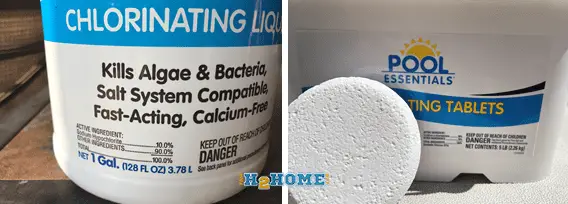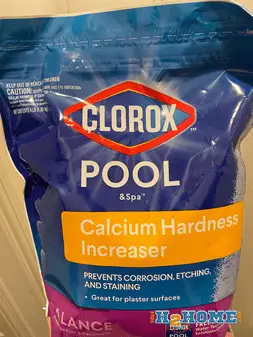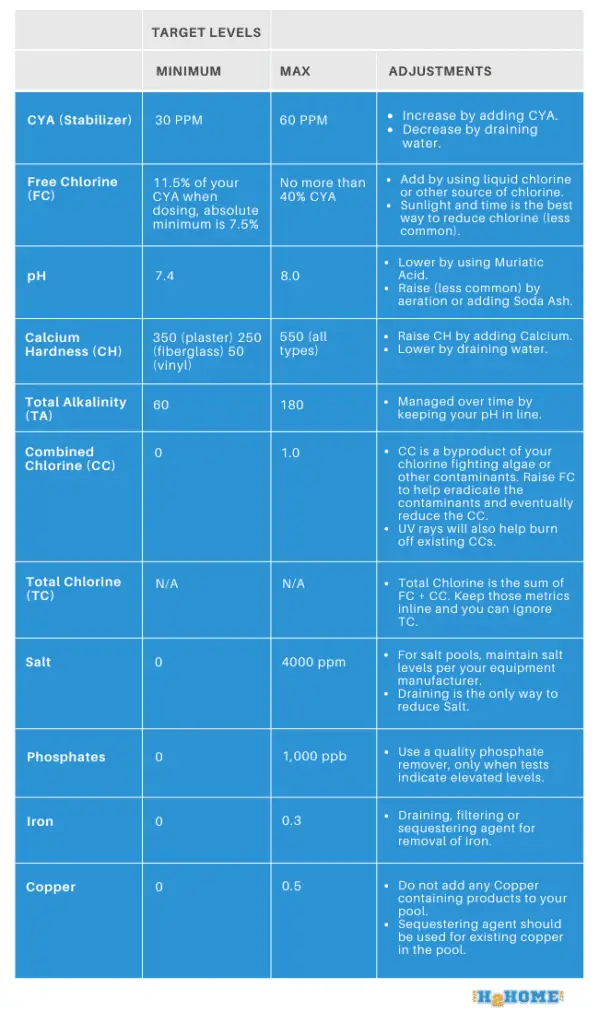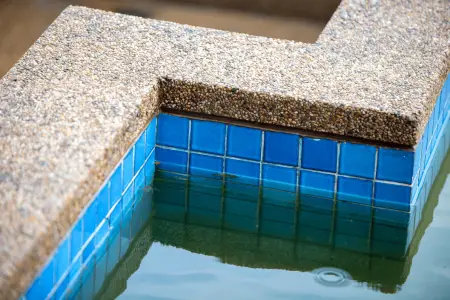Taking care of your pool is often intimidating and confusing to new pool owners. This guide will break down the various aspects of pool testing, educate you on how to properly adjust your levels, and get you on the road to taking care of your pool.
Your pool is a significant investment and a source of enjoyment for your entire family, and nobody can take care of it better than you. I offer the same advice to my clients and apply the same level of care to my pool.
Types of Pool Testing
The most accurate type of testing for residential pool testing is one that uses drops of liquid reagents applied to a sample of your pool water. This method is called titration, and while it can feel like you are back in high school chemistry class, it is easy to do and offers the most accurate results of all of the testing types.
Digital testing kits offer the comfort of a digital readout of the test results. While comforting, these require frequent calibration to provide accurate test results.
Test strips are the easiest way to test your pool, but are neither precise nor accurate and are not recommended.
Test Kits Recommendations
I recommend a quality test kit that allows you to accurately measure Free Chlorine (FC), pH, Cyanuric Acid (CYA), Calcium Hardness, and Total Alkalinity. Test kits that measure all of these can be expensive, but offer you greater insight into what your pool requires and will end up paying for themselves by avoiding costly mistakes or unnecessary chemicals.
Two of my favorite test kits are the Taylor K-2005C and the TF-100 which also uses Taylor branded reagents.
- K-2005C Service Complete Swimming Pool Test Kit
- Includes 2 oz reagent bottles.
- High Range (HR) kit.
While I recommend the above two test kits, some people prefer the ease of a digital tester. The ColorQ by LaMotte is a quality test kit that does not require frequent recalibrations like many digital testers and also covers the 5 key measurements.
- LaMotte 2056 ColorQ Pro 7 Digital Pool Water Test Kit (Uses liquid reagents for all test factors except Cyanuric Acid, which uses tablets.)
Note the two items I did not recommend were test strips or pool-store testing. Test strips are not precise and often not accurate. Pool store testing is only as good as the employee testing and calibrating the equipment.
Top 5 Pool Testing Measurements
Cyanuric Acid (CYA)
Cyanuric Acid is frequently referred to as conditioner or stabilizer as its main job is to protect your chlorine from sunlight. Since the CYA holds some of your chlorine in reserve, your CYA levels drive your target level for your chlorine
As CYA drives your most important chemical level (chlorine), it is the #1 measurement you need for your pool.
Target Cyanuric Acid Levels
For an outdoor pool, the recommended CYA level is between 30 and 60. Your climate and the amount of sun your pool receives will drive your exact target level. For example, a pool in Arizona receiving full sun should target a CYA of 60 while a pool in New Jersey that receives shade most of the day can target 30 for their CYA.
Adjusting Levels
Increasing your CYA is easy, simply add CYA or pool stabilizer making sure to follow the directions for your product and pool size. Note that CYA can take several days to fully dissolve and I recommend running your pump for at least 2 days straight and avoid cleaning your filter for at least 7 days as CYA graduals can get trapped by the filter and take a while to dissolve.
- Helps chlorine last longer
- Reduces sun's impact on chlorine
- Perfect for salt pools, new pools and pools that use liquid chlorine
- For best results, use with the Clorox Pool App
Note, that stabilizer also comes in liquid form. While pricier than the granular form, it is also already dissolved and ready to work almost immediately.
- Size: 1 gallon
- Immediately stabilizes chlorine and protects it from direct UV degradation
- Instant conditioner is a salt and less harsh than acid-based stabilizers
- Pool friendly pH of 8.0 will not have any harsh effects on your pool or...
- Works efficiently in any water temperature and dissolves immediately
I have covered the easy ways to add CYA, but many times pools get too much CYA from continual use of chlorine products that also contain CYA. These high levels of CYA tie up your chlorine and do not leave enough Free Chlorine to fight off the algae, bacteria, and viruses in your pool water.
The best way to rid your pool of excess CYA is to drain off some of your water replace it with tap water as that does not contain CYA. The amount of water you need to drain is proportionate to your % decrease needed. or example, if you are at a CYA of 100 and would like to get to 50, you need to drain 50% of your pool and replace it with tap water.
I do not recommend ever draining more than 50% of your pool water at any given time to avoid damaging your pool. If you require more than a 50% reduction in CYA, you will need to do several partial drains and refills.
Free Chlorine
What is free chlorine?
Free Chlorine (FC) is the portion of your chlorine that is available to sanitize your pool by killing algae, bacteria, viruses, and other contaminants to your pool.
While listed as the #2 test, it is the most important level in your pool and should be tested multiple times per week as the chlorine is used up by the pool and sun.
Chlorine has been used for hundreds of years to keep water clean, is EPA approved, and even found in your drinking water. The Free Chlorine portion of chlorine does not have a strong odor or cause eye irritation.
Target free chlorine evels
Your target FC level is driven by your CYA level. Simply multiply your CYA level by 11.5% to get your target FC level. If your CYA levels are in line with the recommended levels, your target FC will be between 4-9 ppm.
Keep in mind that your FC is consumed by your pool and sunlight every single day and the average loss can be 1-3 ppm per day. It is okay to add chlorine slightly above your target level to account for this daily loss and make sure your pool does not dip too far below the target level.
Adjusting Levels
Generally, you should test and add chlorine every 2-3 days. Chlorine can be added to your pool in a variety of forms:
- Liquid Chlorine -Active ingredient is sodium hypochlorite (bleach) and adds only chlorine to your pool.
- Trichlor Pucks/Powder (Trichloro-S-Triazinetrione) – These convenient pucks or powder add chlorine + CYA to your pool. While convenient, solely using trichlor is not recommended as it can contribute to high CYA and require you to drain your pool to lower the CYA level. Additionally, some manufacturers add blue copper to their products that can also cause staining to your pool surfaces over time.
- Cal-Hypo Powder (Calcium Hypochlorite) is also convenient and adds chlorine + calcium to your pool. Similar to Trichlor, solely using cal-hypo to chlorinate your pool to avoid a future draining of your pool.
- As chlorine is consumed by your pool, you typically want to allow the extra chlorine to be utilized by your pool and the sun. In extreme cases where your FC is > 40% of your CYA, use a product containing sodium thiosulfate to lower your FC.

pH
Water pH tells you if your water is acidic (<7.2) or basic (>8.0) and is an important measurement to protect your equipment and enjoy a comfortable swim.
In general, pool water pH rises over time and will require additions of acid to reduce the pH.
Target Levels
I recommend testing your pH every few days and adjusting your pH down to around 7.4 once it reaches 8.0.
Many people try to micromanage their pH to be the ideal pH of 7.6, which can be a frustrating and time-consuming effort. The natural pH rise is not a constant rise and many times you will see your pH rise from 7.4 to 7.6 in a single day, with a much slower rise to 7.8 and an even slower rise to 8.0. A pH of 7.8 is absolutely fine and okay to let it stay at that level.
Adjusting Levels
Muriatic Acid is the best chemical for adjusting your pH downward. Muriatic acid can be found in pool stores and most hardware stores including the big box hardware stores in either their pool or paint department.
In the rare event that you need to raise your pH, I recommend trying to aerate your water, usually by the use of water features, swimming, or just turning up the jets to agitate the water. You can usually see a rise in pH from these activities in a matter of hours for low pH.
If you need to raise your pH quickly I recommend using Soda Ash (sodium carbonate). Just be mindful that this will also raise your Total Alkalinity (TA) and can also lead to temporary cloudiness of your pool.
Does baking soda clear the cloudiness of your pool. Read this article to learn morel
Calcium Hardness
What is Calcium Hardness?
Calcium hardness indicates the amount of calcium in your water. Calcium is needed in your pool, particularly plaster and pebble pools, but too much plaster can lead to calcium scale and buildup on your pool tile and surfaces.
Target Calcium Hardness Levels
Your target level depends on your pool type, with plaster and pebble pools requiring the most calcium so that your pool water does not steal calcium from your finish.
- Plaster/Pebble finish – CH of 350-550
- Vinyl – CH of 50-550
- Fiberglass – CH of 250-550
Adjusting Levels
Adding calcium to your pool is easy. Pool stores and big-box retailers sell calcium harness increases, which all contain the same active ingredient: calcium chloride. Alternatively, you can switch your chlorine source to cal-hypo, just make sure you are testing regularly to avoid adding too much calcium.
Calcium is not consumed by anything in your pool, so the only way to get rid of excess calcium is to drain and replace water. Keep in mind that your tap water does contain some calcium. In most areas of the country that is fine, but some areas in the southwestern US have high levels of calcium. In those instances, you can fill with softened water or have water delivered that has lower calcium.

Total Alkalinity (TA)
What is Total Alkalinity?
Total Alkalinity is closely tied to your pH and can push your pH up or down if it is out of line. While this is an important measurement, I listed it as the least important of my top 5. TA is important to keep in range, but changing your TA generally takes some time, and does not have large daily swings like you can see with chlorine or pH levels.
Target Alkalinity Levels
My ideal levels for TA range from 60 up to 100, but you can easily manage a pool with a TA up to 180. However, the higher TA levels will also push up your pH level and require more frequent additions of acid to keep your pH in range.
Adjusting Levels
Generally, if you properly monitor and manage your pH your TA will naturally fall into range since the same chemicals that you use to manage your pH are also used for your TA.
To raise your TA, add Soda Ash or Baking Soda. Each are available at grocery stores along with pool and hardware stores.
To lower your TA, I recommend using Muriatic Acid. Note that this will also lower your pH so that should be monitored closely to make sure your pH remains in range. Adjusting your TA downward can take multiple additions of acid over days or weeks.
Other Measurements
Combined Chlorine (CC)
Combined chlorine is the byproduct of your Free Chlorine fighting off algae, viruses, and bacteria. Unlike your Free Chlorine, CC does have a strong smell and can irritate the eyes. If you have ever walked into an indoor pool and been hit with the strong “chlorine smell”, that is the combined chlorine.
Combined chlorine levels generally are 0.0 – 0.5 and anything above 1.0 is an indication that your Free Chlorine is trying to fight off something in the water and may need to be increased to make sure and eradicate the algae, bacteria, or viruses it is fighting.
Combined chlorine is burned off by the UV rays of the sun. If your pool is covered, you may need to uncover it for a day or two to help burn off the CC. Indoor pools will typically need incremental equipment to provide UV to burn off the CCs.
Total Chlorine (TC)
Total chlorine is simply the sum of your Free Chlorine (FC) and Combined Chlorine (CC). Many test kits include testing for Total Chlorine, but I do not recommend testing for this since it is much more effective to measure the FC and CC separately.
Salt
Salt is found in all pool types and is required in saltwater pools for the Saltwater Chlorine Generator to work and produce chlorine.
There is no requirement for salt in a non-saltwater pool, but swimming and chemicals often leave behind salt and many non-saltwater pools end up with salt levels of 600-1,000 ppm.
If you have a saltwater pool, you need to make sure you keep your salt levels within the manufacturer’s recommended levels, typically around 3,000-3,500 ppm. Note that this level is much lower than the salinity of ocean saltwater, which is around 30,000 ppm.
While salt tests are typically not included in many test kits, you can easily purchase a salt test.
- Taylor Technologies K-1766 Salt Water Kit is for use with salt water...
- Country of Origin: United States
- Brand Name: TAYLOR TECHNOLOGIES INC
- Model Number: K-1766
The salt in your pool is not used up and only leaves when the water leaves your pool via splashing, backwashing, or draining.
Phosphates
Phosphates are nutrients in the pool that can feed algae. Phosphates typically enter the pool from fertilizer runoff either directly from your yard or some municipal water supplies contain levels of phosphates up to 300 ppb.
In general, you can rely on chlorine to do its job in killing algae and not have to worry about phosphates. If you do find yourself with phosphates over 1,000 or even 2,000 ppb, feel free to use a phosphate remover found online or at a pool store.
Iron
Iron is generally not a concern for pool owners unless they are on a well with high iron content. Modern pool equipment should not contain any iron components, but some very old equipment or improperly replaced equipment or pipes could contain iron.
If you find yourself with Iron in your water, it can cause staining to pool surfaces usually yellow in color, or may cause brown/reddish water if there are suspended iron particles in your water.
The best way to prevent iron is to check your fill water source for iron. Once it is in your water, you can either filter it out, replace the water, or use a metal sequestering agent to prevent staining.
Copper
Copper can cause staining to your pool surface and is not generally something you want in your pool. Unfortunately, copper does kill algae and is included in many pool products marketed as “Blue” including chlorine pucks and copper-based algaecides or “Mineral” cartridges for some pool equipment.
I do not recommend using any pool products containing copper. Yes, it kills algae but it can cause problems like green hair and staining of pool surfaces.
If you do find yourself with copper in your water you can use a sequestering agent to keep it in suspension.
- Removes copper stains and scale buildup
- Compatible with all pool types and surfaces
- 2 Pack
FAQ
How often do I need to test my pool?
When first starting, I recommend testing FC and pH daily and performing the TA, CH, and CYA tests weekly. Once you get a feel for your pool needs, you can back off of the pool testing a bit but make sure you stay on top of your FC and pH no less than weekly when the pool is in use.
Can’t I leave the testing to the professionals?
You can, but I do not recommend it. With your own testing, you can control the testing to ensure that you have accurate test results and only use what your pool needed. Pool stores offer you free testing for a reason and their ultimate goal as a business is to sell you their products.
How do I add chemicals yo my pool?
For liquids such as liquid chlorine or muriatic acid, pour a pencil-sized stream in front of a return jet preferably in the deep end. For solid chemicals, follow the manufacturer’s directions. Liquid and solid chemicals should be added when the pool is running and the pool should not stop running until all chemicals are properly dissolved and mixed with the water.
Recommended Levels
Below is a summary of the recommended chemical levels for your pool:

Conclusion
I truly believe that nobody can take care of your pool better than you can. I hope this guide gives you the confidence and tools to tackle the challenge of taking care of your pool.

I am passionate about taking care of pools and started over 20 years ago as a young entrepreneur taking care of several neighbor’s pools in the Houston, TX area. Now I live in Prosper, TX, and am known as the Prosper Pool Consultant:
I specialize in solving short-term pool issues with the goal of educating that customer so that they never need my services in the future. It is a unique business model, but I find it very rewarding to see pool owners gain the confidence and tools to manage their pools themselves.






